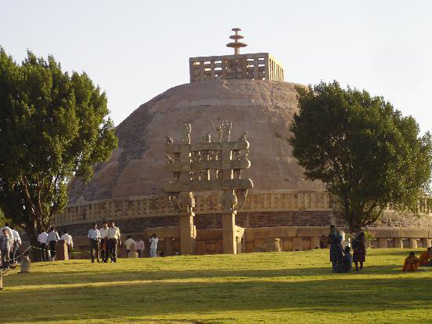 Marvelous monuments motivated by a King’s love
Marvelous monuments motivated by a King’s love
A quaint little village at the footsteps of a hill, Sanchi in the Indian State of Madhya Pradesh carries the genesis of Buddhism in India. A tiny hamlet with a rich culture, Sanchi is embellished by a series of monasteries, stupas, holy shrines and pillars dating from 3rd century BC to 12th century AD. The glory of Sanchi, as a devout centre, can still be experienced in its composite formations where the rich carvings reflect various legendary beliefs and Buddhist myths.
Though Sanchi’s history hangs around the Buddhist monuments, it is amazing to believe that Lord Buddha never visited Sanchi during his lifetime. Nevertheless, in the soothing stillness of Sanchi one could perceive his presence more effectively than any of the other famous Buddhist centers.
Formerly known as Vidishagiri, Sanchi was a busy trading center and a hub of affluent merchants. Sanchi owed much to these mighty merchants for their wholehearted patronage, which helps it to thrive as a leading center of Buddhist tradition.
Sanchi also unfurls a true love story that is nothing short of a fairy tale. It’s about a beautiful girl by name Devi, a pious Buddhist. King Ashoka fell in love with Devi and it is believed she motivated the king to construct such marvelous monuments in Sanchi.
Sanchi’s fame set in to oblivion by the end of the 13th century and only in 1818 this renowned center of Hinayana Buddhism was rediscovered. Despite the neglect for centuries, the architectural splendors of Sanchi still adorn the prime position and it offers the most redolent and eye-catching Buddhist site in India. Stupas and gateways of this world heritage site are superb expressions of classiness in architecture. In fact these marvels of ancient Buddhist ethnicity herald a new arena in the field of temple architecture in India.
Apart from the religious and historical aspect, Sanchi tenders a delightful view of the adjoining landscapes. If religion is not your passion, you could move onto other options since Sanchi is a fine place to just chill out and rest, or travel around.
History
Going back to the Sunga Period (2nd century BCE) the city was under the rule of Pusyamitra Sunga, who is believed to have destroyed the main Stupa which was later rebuilt by his son Agnimitra. King Asoka, belonging to the Mauryan dynasty, built the giant Stupa in the 3rd century.
The Satavahana Period lasted around 70 BCE and it was during this time that the gateways and the banister were built. The abundant amounts of stone carvings depicting the life of Buddha were also built during this age. Not much of the history is known from then onwards.
It was in the 12th century that the city saw the establishment of most of its temple. After the decline of Buddhism in India, most of the historical monuments of Sanchi dilapidated. The present town of Sanchi was brought back to glory by the British General Taylor, who discovered the site in 1818. Restoration of the site was commenced under the guidance of John Marshall in 1912 and was completed in 1919.
The site gained momentum of being UNESCO World Heritage Site in the year 1989.
Attractions
Ashoka Pillar: Put up in the third century, this Greco Buddhist style structure stands as a proud testimonial to the rich legacy of Sanchi. The brilliantly carved pillar is renowned for its aesthetic beauty and sumptuous proportions.
Buddhist Vihara: An important center of Buddhist culture, Sanchi encompass so many Buddhist Viharas and shrines. One could be able to see all forms of Buddhist architecture here. Among the relics of this great culture, Viharas take the predominant position.
Sanchi Museum: A proud testimonial to the rich cultural and religious heritage of India, Sanchi Museum houses invaluable objects that belong to the early years of fist to third centuries. It has now become one among the alluring tourist attractions in Sanchi.
Sanchi Stupa No 1: Dating back to 3rd century, this stupa is meant to keep the remnants and has been found with relics of the disciples of Buddha.
Stupa No 2: Placed at the periphery of the hill, Stupa number 2 is characterized by the striking stone railings that surround it. Built in the 2nd century BC, this Stupa is placed on an artificial podium and it lies beneath all the other Stupas.
Stupa No 3: Lying adjacent to the great Stupa, Stupa no. 3 is also referred to as the most striking edifice of Buddhist as well as Mauryan arts. In design, Stupa number one and three are akin.
The Eastern Gateway: Constructed in 35 BC, the four gateways in Sanchi portray important incidents in the life of Buddha. Popularly called as Toranas these gateways are named as eastern, western, southern and northern. Elephants facing four directions support the architraves of this gate.
The Great Bowl: As the cradle of Buddhist renaissance, Sanchi houses a vast expanse of glorious monuments that reflect the religious norms of the past centuries. All these monuments are put atop a hill that overlooks the plains and these structures were the major center of Buddhism till the end of 12th century.
Best time to visit: Best period to visit Sanchi is from October to March.
How to reach
By Train: Bhopal is the nearest railhead, which is 50 km away from Sanchi. Bhopal is a major railway junction, which is placed in the Mumbai – Delhi broad gauge line.
By Air: Raja Bhoj’ Airport in Bhopal is the nearest airport. It is 67 km from Sanchi. Air India offers flights to Sharjah and Dubai from Bhopal.
By Bus: Government owned public buses and private luxury buses provide services from Sanchi to many cities, including places like Bhopal (46 km), Indore (287 km) and Vidisha (10 km).






